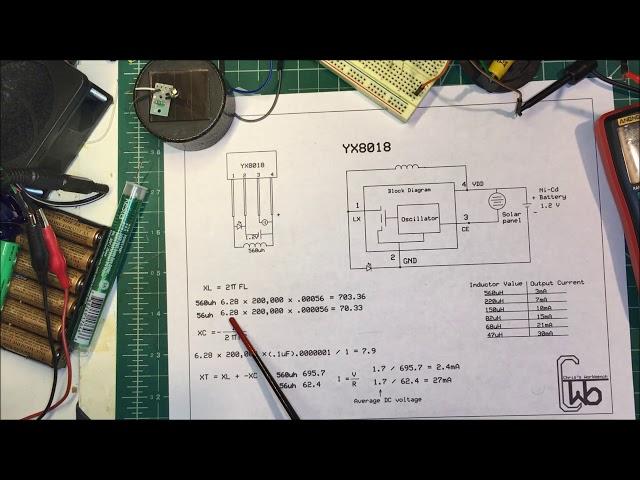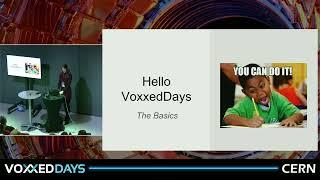Комментарии:

Thanks for the good explanation
Ответить
Where I can get the data sheet?
Ответить
mine has the XY805. I think it's about the same. I married it with a tiny 5v booster and got 8.2v out. must be the freq spikes boosting the booster. but anyway it works for the experiment. I'll be going for the 10uH inductor, that's 90mA that I'm going to force it to muster. Perhaps a heat sink.
Ответить
Energizer rechargeable battery are suitables ?
Thanks.
Marc.

I have taken apart two of them, one has yx805 with AAA, and yx8018 with AA nicad.
Neither of them have a coil or capacitor. what up with that?
Ahh, the coil looks like a resistor, I'm used to surface mount coils, not these little ones.
Let me add that you glossed over the diode used for the solar panel. There is a diode between the CE and GND pins.
I use one of these to charge up a 3.2v lithium cell instead of light up a led, using the AA as a buffer/capacitor to take in the solar.

I have a question:
if i wanted to replace the 1.2V Ni-Cd battery with a 18650 lithium-ion battery what adjustment would I have to make?

Are you sure there is a capacitor in the oscillator? Do you know what kind of oscillator is in there? I was thinking that the LED was only lighting directly from the collapsing magnetic field of the inductor.
Ответить
Here is how it works, there is a common ground between the battery, LED's and the solar panel.
Then you have 1,2,3,4 pins on the IC, say 3 is ground, 1 is solar positive, and 2 and 4 are battery positive and negative.
When the sunlight is out, the voltage from the panel connecting to pin 1, it activates the IC's charging circuit, essentially it just enables the solar positive to connect through to pin 2 which is battery positive, and because all are common on the ground outside of the IC itself, this makes a complete connection with the batter with the solar panel and it's charging.
Once the sunlight is gone, the battery positive no longer has contact with the solar panel positive, as pin 1 is deactivated.
During this phase, pin 2, 3 and 4 will be used. 2 and 4 are connected to battery positive and negative, and pin 3 is connected to the common ground.
What the IC does here, is that pin 4 which connects the negative of the battery to the inductor, it turns this on and off very vast, when it's on the battery current flows into the external inductor coil, and when it's off the circuit for the inductor that would go via the battery is cut off and so is it's energy source, as a result the inductor magnetic field collapses and this doubles the voltage in a voltage spike, and that spike is enough to cross the LED's, which on the other side of them is a line connecting to the common ground that finds it's way to the battery negative.
Thus, it's lit via a series of pulses of higher voltage, if you can film in incredibly high speed you will note the LED technically is flashing, but it's just too fast for our eyes to normally see it, so it looks like it's permanently on.
Older solar garden lights used to have separate power diodes on the board, this was to stop backflow from the battery into the panel typically. I think the newer IC's however have that functionality built in between pin 1 and pin 2, so it's not necessary, which is why you don't see them in most solar lights anymore.
I even have a solar garden light that is using a zener diode as well in place of a power diode, it also will conduct only at a certain voltage, so they used it.
But the most typical one these days is just the IC and the inductor. It's actually nice to get one that has more components however, getting more bang for your buck. But for use as a solar garden light itself, I prefer the new IC and just the inductor, it seems to have less chance of failure over the long term. The new IC's are purpose made for solar lights, where as I believe the original solar garden slights used IC's that were not purpose made, that's why they had to use additional components sometimes.

So the yx8018 only "protects" the battery by dropping the voltage a bit via a diode, would that mean that I could use a different battery technology such as lead acid or lithium if I were to pick the right solar panel voltage?
Ответить
Hi I rigged up one YX8018 circuit in a bread board. For 47uH inductor the LED current was 0.01A but the current drawn from the battery was 0.03A. I changed the inductor to 33uH and the the LED current was fluctuating between 0.01A to 0.02A but the current drawn from the battery was 0.05A.
Now I am confused if the inductor value correspond to input current drawn by the battery or its really the LED current.

I just bought a few of these for no reason some time ago. And it turned out they were also my my rusted solar light. I actually manager to repair it by replacing the yx805 in my case. I coz for the price it's pratical to have a few lying around. They seem to be in all budget solar lights these days.
Ответить
Would it work as a youle thief when I do not connect any solar panel? I just want to supply battery power and have it boost the voltage for the led.
Ответить
Thank you for sharing, I have a question. I add a 3v battery and a led for this voltage and the system never turn off, please what I have to do to modify and use it with 3v dc?
Ответить
Thank you.
Ответить
ты в маске?
Ответить
I have noticed that with this chip (YX8018) the lights don't go dim they just turn off. Is this some protection for the NiMH battery?
The ANA618 chip for instance just keeps working until the battery doesn't have enough energy to continue.

Excellent video!
Ответить
Hello! I am very much a novice. I have a cheap solar light based on this chip. It has a 330 micro Henry inductor. I put in a Straw Hat RGB Slow-Flash color-changing LED. Tested the LED on a bread board. It works. It is stuck on red in the solar circuit. I think I know why. I am getting only 1.2 volts driving the LED. Something is clearly amiss. Which pin on the 8018 is pin 1? I am guessing on the label side, it is the left-most pin. The impedence of the inductor is low, so I guess it is good. What do you suppose is the problem? Thanks!!!!!
Ответить
Hi, i have been working with 3v 50x50 solar panels but theyre expensive, is this a 1.5 cheaper panel?, thanks for sharing!! Very well explained
Ответить
Hello, can you tell me how i can measure with multimeter the average DC-Voltage or other? Is it possible? Because i dont know why 1,7V. And the MilliAmps are not so.. On 82 uH i have 18 mA insterad of 15mA, if 1.7V Average... And 68 uH i have 22 mA. 47 uH i have 34 mA ;) On Which Pins from YX8018 must i Measure this Effect?
Ответить
Sharing your knowledge and info about electronics is highly appreciated and my heartfelt gratitude for doing so. Your channel is very informative and the tutorials are great and I really learned a lot. Thank you and looking forward for more videos. Cheers!
Ответить
Thanks for your positive response and uploading the sheets
Ответить











